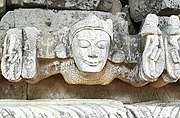Kamata Kingdom
The Kamata Kingdom (pron: ˈkʌmətɑ) emerged in western Kamarupa when Sandhya, a ruler of Kamarupanagara, moved his capital west to Kamatapur sometime after 1257 CE.[4] Since it originated in the old seat of the Kamarupa kingdom, and since it covered most of the western parts of it, the kingdom is also sometimes called as Kamarupa-Kamata.
Kamata Kingdom | |||||||||||
|---|---|---|---|---|---|---|---|---|---|---|---|
| c1257–1587 | |||||||||||
| Capital | Kamatapur | ||||||||||
| Common languages | Early Assamese | ||||||||||
| Religion | Hinduism | ||||||||||
| Historical era | Medieval India | ||||||||||
• Established | c1257 | ||||||||||
• Disestablished | 1587 | ||||||||||
| |||||||||||
| Today part of | India (North Bengal, Lower Assam), Bangladesh | ||||||||||
| Part of a series on the |
| History of Assam |
|---|
 |
|
Proto-historic |
|
Late Medieval |
|
Modern |
|
Contemporary |
| Categories |
|
| Part of a series on the |
| Culture of Assam |
|---|
 |
|
Proto-historic
Classical Medieval
Modern |
|
|
|
Festivals
|
|
Religion Major
Others |
|
History
Archives
Genres
Institutions
Awards
|
|
Music and performing arts |
|
Media |
|
Symbols
|
It covered a region corresponding to present-day undivided districts of Kamrup, Goalpara, Jalpaiguri, and Koch Behar in India and Rangpur and northern parts of Mymensingh in Bangladesh.[5] The rise of the Kamata kingdom marked the end of the ancient period in the history of Assam and the beginning of the medieval period. The last rulers were the Khens, who were later displaced in 1498 by Alauddin Hussain Shah, the Turko-Afghan ruler of Gauda. Though Hussain Shah developed extensive administrative structures, he lost political control to a confederation of Baro-Bhuyan within a few years.
Biswa Singha removed Baro-Bhuyan confederacy and established the Koch dynasty soon, in 1515. The Koches were the last to call themselves Kamateshwars (the rulers of Kamata), but their influence and expansions were so extensive and far-reaching that their kingdom is sometimes called the Koch Kingdom. In the same century the kingdom split in two: Koch Bihar and Koch Hajo. The eastern kingdom, Koch Hajo, was soon absorbed into the Ahom kingdom in the 17th century. The western portion of the Kamata kingdom, Koch Bihar, continued to be ruled by a branch of the Koch dynasty and later merged with the Indian territory after the independence of India from the British domain.[6] The boundary between Koch Bihar and Koch Hajo is approximately the boundary between West Bengal and Assam today.
Rulers of Kamata kingdom
Early rulers
Sandhya, a successor of Prithu, was a ruler of Kamarupanagara, the capital of the erstwhile Kamarupa.[7] After withstanding an attack from Malik Ikhtiyaruddin Iuzbak, in which Iuzbak was killed (in 1257), Sandhya moved his capital to Kamatapur, near present-day Cooch Behar town. Sandhya styled himself Kamateswara and the kingdom came to be known as Kamata.[8]
- Sandhya (1228–1260)
- Sindhu Rai (1260–1285)
- Rup Narayan (1285–1300)
- Singhadhwaj (1300–1305)
Middle rulers
Pratapdhvaj was a minister of Singhadhvaj when he usurped power. At his death, his cousin Dharmanarayan seized power. He was challenged by Pratapdhvaj's son Durlabhnarayan and they decided to settle. Durlabhnarayan assumed power Kamrup, Goalpara, Jalpaiguri, Koch Bihar, along with the capital Kamatapur, while Dharmanarayan retained Rangpur and Mymensingh.[9][10] As part of the settlement in about 1330, Durlabhnarayan received from Dharmanarayan the custody of fourteen families of Brahmans and Kayasthas, one among whom was Candivara, the great-great-grandfather of Sankardev.[11] The court poets of Durlabhnarayan (Hema Saraswati and Harivara Vipra) and Indranarayan produced literary works that are considered to be the first examples of Early Assamese.[12]
- Pratapdhvaj (1305–1325)
- Dharma Narayan (1325–1330)
- Durlabh Narayan (1330–1350)
- Indra Narayan (1350–1365)
Baro-Bhuyan rule
The invasion of Assam by Sikandar Shah (1357–1390) weakened Indranarayan. Though Shah had to retreat from central Assam because of an attack on Bengal by Firuz Shah Tughlaq, Indranarayana was sufficiently damaged that a Bhuyan from Darrang, Arimatta, was able to usurp power.[13]
- Sasanka (Arimatta) (1365–1385)
- Gajanka (1385–1400)
- Sukranka (1400–1415)
- Mriganka (1415–1440)
Khen dynasty[14]
- Niladhwaj (1440–1460)
- Chakradhwaj (1460–1480)
- Nilambar (1480–1498)
Bengal Sultanate rule
- Alauddin Hussain Shah
Alauddin Hussain Shah (c1494-1519), an Afghan ruler of Gauda, removed the last Khen ruler in 1498.[15] According to tradition, this involved an instigation by the minister of Kamatapur whose son had a liaison with the Kamatapur queen, and Hussein Shah invaded the Kamata kingdom with 24,000 infantry, cavalry and a war flotilla.[16] After a long seize of the Kamatapur fort and a treacherous win, Hussein Shah finally destroyed the city and annexed the region up to Hajo, thereby regaining much of the land Bengal had lost earlier to Kamatapur, and some more. Hussein Shah's son was made the viceroy.
Hussein Shah removed the local chieftains and established military control over the region. He issued coins in his name "conqueror of Kamru, Kamata". His conquest expanded the kingdom to central Assam. Hussein Shah finally lost military and political control to revolts by local chieftains including the Bara Bhuyans first and later to the Ahom king, Suhungmung, and the region lapsed into local control and rise of the Koch dynasty.
Nevertheless, the Afghan rule had lasting effects. Hussein Shah's coins continued to be used till 1518, when the Koch dynasty began consolidating their rule. Ghiasuddin Aulia, a Muslim divine from Mecca, established a colony at Hajo. His tomb, which is said to contain a little soil from Mecca, now called "Poa Mecca" ("a quarter Mecca"), is frequented by Hindus and Muslims alike.[17]
Interregnum
Alauddin Hussain Shah's representative in Kamata, his son Danial and his officers, was seized and killed by the Bara Bhuyans of the region and the region lapsed into their confederated style of governance.
Koch kingdom
- Vishwa Singha (1515–1540)
- Nara Narayan (1540–1587)
The Kamata kingdom then passed into the hands of the Koch people, with Vishwa Singha consolidating his control over one Bara-Bhuyan after another and establishing the Koch dynasty. In the 16th century Raghudev, the son of Chilarai and the nephew of Nara Narayan affected a split in the kingdom—Koch Bihar and Koch Hajo. The two parts remained separated, the boundary between them forming roughly the administrative boundary between the present-day Assam and West Bengal.
Koch Hajo, the eastern kingdom, soon came under attack from the Mughal, and the region went back and forth for between the Mughal and the Ahoms, finally settling with the Ahoms. Koch Bihar, the western kingdom, first befriended the Mughals and then the British, and the rulers maintained the princely state till the end of the British rule.
See also
- Koch–Ahom conflicts
- Koch Rajbongshi people
Notes
- "639 Identifier Documentation: aho – ISO 639-3". SIL International (formerly known as the Summer Institute of Linguistics). SIL International. Retrieved 29 June 2019.
Ahom [aho]
- "Population by Religious Communities". Census India – 2001. Ministry of Home Affairs, Government of India. Retrieved 1 July 2019.
Census Data Finder/C Series/Population by Religious Communities
- "Population by religion community – 2011". Census of India, 2011. The Registrar General & Census Commissioner, India. Archived from the original on 25 August 2015.
- "Kamarupa was reorganized as a new state. 'Kamata' by name with Kamatapur as capital. The exact time when the change was made is uncertain. But possibly it had been made by Sandhya (c1250-1270) as a safeguard against mounting dangers from the east and the west. Its control on the eastern regions beyond the Manah (Manas river) was lax." (Sarkar 1992, pp. 40–41)
- (Sarkar 1992, p. 39)
- http://coochbehar.nic.in/htmfiles/royal_history2.html
- (Baruah 1986:175)
- (Baruah 1986:176)
- (Baruah 1986:177)
- (Sarkar 1992:41f)
- (Neog 1980:50)
- (Baruah 1986:178)
- "Indranarayan's inability to resist the Muslims paved the way for the rise of the Bhuyans. Indeed, one of them, Arimatta or Sasanka became so ambitious that he killed Indranarayan and usurped the throne of Kamata." (Baruah 1986:178–179)
- (Sarkar 1992:44)
- The dates and duration of this invasion are not well established. See (Sarkar 1992:46–47).
- (Sarkar 1992:46)
- (Sarkar 1992:48)
References
- Baruah, S L (1986), A Comprehensive History of Assam, New Delhi: Munshiram Manoharlal Publishers Pvt. Ltd.
- Boruah, Nirode (2011). "Kamarupa to Kamata: The political Transition and the New Geopolitical Trends and Spaces". Proceedings of the Indian History Congress. 72: 78–86. JSTOR 44146698.CS1 maint: ref=harv (link)
- Neog, Maheshwar (1980). Early History of the Vaishnava Faith and Movement in Assam. Delhi: Motilal Banarsidass. ISBN 9788120800076.CS1 maint: ref=harv (link)
- Sarkar, J. N. (1992), "Chapter II The Turko-Afghan Invasions", in Barpujari, H. K. (ed.), The Comprehensive History of Assam, 2, Guwahati: Assam Publication Board, pp. 35–48
